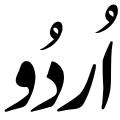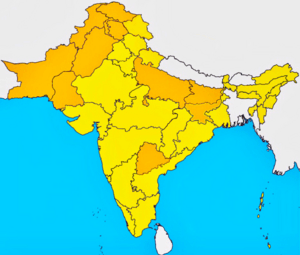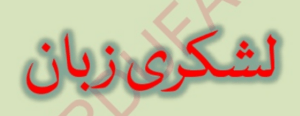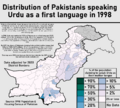Urdu facts for kids
Quick facts for kids Urdu |
||||
|---|---|---|---|---|
| اُردُو | ||||

Urdu in Nastaʿlīq script
|
||||
| Region | South Asia (native to the Hindi-Urdu Belt) | |||
| Ethnicity | None | |||
| Native speakers | 50.7 million in India 16 million in Pakistan (2007 and 2017) |
|||
| Language family |
Indo-European
|
|||
| Writing system |
|
|||
| Official status | ||||
| Official language in | Official: Secondary Official: |
|||
| Recognised minority language in | ||||
| Linguasphere | 59-AAF-q | |||

Areas where Urdu is either official or co-official Areas where Urdu is neither official nor co-official
|
||||
|
||||
Urdu, also known as Lashkari or a Lashkari language, is an Indo-Aryan language. It is the national language of Pakistan. It is spoken as a lingua franca by the majority of people in Pakistan and it is also spoken in some parts of India like the states of Telangana, Andhra Pradesh, Delhi, Bihar and Uttar Pradesh. When spoken, it sounds the same as Hindi with exceptions of certain vocabulary words, phrases or tone of speaking. When written, it is written completely different from Hindi. That is why, speakers of Hindi and Urdu can have a fluent, easy conversation with one another, but they cannot read or write letters to one another.
Contents
History
Urdu was believed to have developed in 11th century in Lahore during the Ghaznavid Empire, centuries before it became known as Urdu. Urdu is evolved from Apabramsa of Shauraseni Prakrit. Urdu is a major form of Hindustani. The origin of the name Urdu is the Chagatai language's word for army, urdu. Informal Urdu is spoken the exact same as modern-day informal Hindi, with the exceptions of some vocabulary differences. Hindi uses the traditional Devanagari script (from Sanskrit), whereas Urdu uses the Persio-Arabic alphabet and relies heavily on Persian vocabulary with influences from Arabic as well. The poet Ghulam Hamadani Mushafi coined the term 'Urdu' for this language in 1780. However, this began to alienate the two major cultures in India/Pakistan, the Muslims and Hindus. Hindus began to speak and write Hindi, whereas Muslims would begin to speak Urdu. This also lead to a need to "cleanse" Urdu of all its Sanskrit words and lead Hindi speakers to want to be rid of Persian words that remained in their language. in 1882 Arya Samaj argued that, Urdu should written in the Devanagari script, which started the controversy named, Hindi-Urdu controversy, and makes a divide of Urdu language, Urdu for Muslims and Hindi for Hindus.
Relations to Persian
Differences
The letters in Urdu are derived from the Persian/Farsi alphabet, which is derived from the Arabic alphabet. The additional letters that are found in Urdu include ٹ ,ڈ ,ڑ (ṫ, ḋ, ṙ). To make the alphabet more enriched two letters were created for sounds ه (h) and ی (y). By adding these letters to the existing Persian letters the Urdu alphabet became more suitable for the people of North India and Pakistan.
Similarities
Urdu is written right to left like Farsi (Persian) script. Urdu is also written in the Nasta’ liq style of Persian Calligraphy. Nastaliq style is a cursive script invented by Mīr ʿAlī of Tabrīz, a very famous calligrapher during the Timurid period (1402–1502).
Levels of formality
Informal
Urdu in its less formalized register has been called a rekhta (ریختہ, ), meaning "rough mixture". The more formal register of Urdu is sometimes called zabān-e-Urdu-e-mo'alla (زبان اردو معلہ), the "Language of Camp and Court."
In local translation, it is called Lashkari Zabān (لشکری زبان []) meaning "military language" or "military tongue" or "Hordish language". This can be shortened to Lashkari.
The etymology of the word used in the Urdu language for the most part decides how nice or well done your speech is. For example, Urdu speakers would distinguish between پانی pānī and آب āb, both meaning "water" for example, or between آدمی ādmi and مرد mard, meaning "man." The first word is ad derivative from Adam (آدم) Arabic mean from Adam and it can be used for both man and woman in place of human being. Second word مرد mard refers to a gender or can be used for manly hood as well.
If a word is of Persian or Arabic origin, the level of speech is thought to be more formal. If Persian or Arabic grammar constructs, such as the izafat, are used in Urdu, the level of speech is also thought more formal and correct. If a word is inherited from Sanskrit, the level of speech is thought more colloquial and personal. The reason perhaps is the Moghuls (Turks ) influence over India deeming Sanskrit to be a lesser language than Persian or Urdu itself. For the longest time Persian was also official language of Moghul occupied territories.
Formal
Urdu is supposed to be a well formed language; many of words are used in it to show respect and politeness. This emphasis on politeness, which comes from the vocabulary, is known as Aadab ( Courteous ) and to sometimes as takalluf (Formal) in Urdu. These words are mostly used when addressing elders, or people with whom one is not met yet. Just like French Vous and Tu. Upon studying French and other forms of Language similar formal language construct are present. The whole grammatical layout appears to be almost identical to French language structure. The rules to form sentences and structuring them are identical
Poetics
Two very respected poets who are not only celebrated in the Indian subcontinent but are famous in many other communities worldwide are Mirza Ghalib and Sir Mohammad Iqbal.
Mirza Ghalib
Ghalib (1797-1869) is famous for his classic satire and sarcasm as seen in the following verse;
(Latin/Roma alphabet):
Umer bhar hum yun hee ghalati kartey rahen Ghalib
Dhool ch-herey pei thee aur hum aaina saaf karte rahe
(translation):
O Ghalib (himself) all my life I kept making the same mistakes over and over,
I was busy cleaning the mirror while the dirt was on my face.
Sir Mohammad Iqbal
Iqbal (1877-1938) was a poet, and an active politician. He focused his poetry on bringing out the plight of the suffering Muslim community. In his poetry he very boldly highlighted the missing virtues and values in the morally corrupt society. Despite much opposition in the beginning, he ended up leaving a huge impact. He is also called the “Poet of the East” and the “Poet of Islam”. His work is displayed in the following verse;
(Latin/Roma Alphabet):
Aapne bhe khafa mujh sei beganey bhe na khush
Mein zeher -e-halahal ku kabhi keh na saka qand
(translation):
I could not keep happy either my loved ones nor the strangers,
as I could never call a piece of poison a piece of candy.
Iqbal is considered by many an inspirational poet. He played a large role in the Pakistan Movement, with many claiming that he was the one to spark it.
Common Words/Phrases in Urdu
Formal Urdu:
Aap tashreef rakhein = Please have a seat
Me mu'azzarat chaahta/chaahti hun = Please excuse me/I apologize
Informal Urdu: Aap bethein (You sit) or Tum betho (Sit, more informal)
Me maafi chaahta/chaahti hun= I ask for forgiveness
*************
Aap kese hein? = How are you?
Me theek hun = I am fine
Assalam O Alaikum = Peace be upon you (It basically means hello, and it is a common greeting used in Islamic countries or among Muslims in general)
Urdu vs Hindi--What's the difference?
Urdu is a language spoken primarily in Pakistan. Its grammar and sentence structures are similar to, or rather exactly like Hindi, a language spoken primarily in India, which makes Hindi and Urdu speakers be able to have an easy, fluent conversation. Urdu and Hindi are very mutually intelligible with one another.
Urdu has a majority of its vocabulary words and phrases borrowed from Persian and Arabic, languages spoken in Iran, Afghanistan, and in many countries of the Middle East. Urdu's written script is also in the exact alphabets and scripts of Persian-Arabic. That is why, they are able to read and write easily in Arabic and Persian. Urdu is the Persianized form of Hindi.
Name of colors, objects, feelings, and more are all different in Urdu than in Hindi. They are primarily used in books, shows, and poetry, with the Persian words used and understood, seen as more formal and Urdu. However, informal Urdu, which is spoken among family members and friends in Pakistan, basically use the Hindi words for many things as well, as Pakistan and India used to be a single country and only recently came to split in 1947. That is why, you will not easily distinguish between an Urdu versus a Hindi speaker in informal, day to day conversations unless they use vocabulary specific to either one of their languages. That is why, you will often see many YouTube videos or movies stating their language as "Urdu/Hindi". Books and articles will not have "Urdu/Hindi" written since these two languages use completely different scripts alien to one another.
You can think of Urdu as British English written in Chinese alphabets and Hindi as American English written in Egyptian hieroglyphs--except with more vocabulary differences and less accent differences (with some tone differences).
Other sources
- Encyclopædia Britannica Nastaʿlīq script
Images for kids
-
A multilingual New Delhi railway station board. The Urdu and Hindi texts both read as: naī dillī.
-
An English-Urdu bilingual sign at the archaeological site of Sirkap, near Taxila. The Urdu says: (right to left) دو سروں والے عفاب کی شبيہ والا مندر, dō sarōñ wālé u'qāb kī shabīh wāla mandir. "The temple with the image of the eagle with two heads."
See also
 In Spanish: Urdu para niños
In Spanish: Urdu para niños








